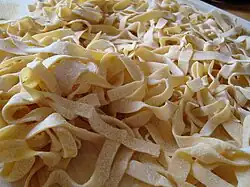 Fresh, uncooked fettuccine | |
| Alternative names | Fettucce (wider), fettuccelle (narrower) |
|---|---|
| Type | Pasta |
| Place of origin | Italy |
| Main ingredients | Flour, eggs |
Fettuccine (FET-toot-CHEE-nay; Italian: [fettutˈtʃiːne]; lit. ''little ribbons''; SG fettuccina) is a type of pasta popular in Roman cuisine. It is descended from the extremely thin capelli d'angelo of the Renaissance[1] but is a flat, thick pasta traditionally made of egg and flour (usually one egg for every 100 grams or 3.5 ounces of flour). At about 6.5 mm (1⁄4 inch), it is wider and thicker than, but similar to, the tagliatelle typical of Bologna,[2][3] which are more common elsewhere in Italy and is often used as a synonym. Spinach fettuccine is made from spinach, flour, and eggs.
The terms fettucce and fettuccelle are often used as synonyms for this pasta, but the former term is more precisely used for wider (about 13 mm or 1⁄2 inch) and the latter for narrower (about 3 mm or 1⁄8 inch) forms of the same pasta.[4]
Fettuccine is often classically eaten with sugo d'umido ("beef ragù") or ragù di pollo ("chicken ragù").[3] A famous dish made with fettuccine is fettuccine Alfredo, a simple dish of pasta, parmesan cheese, and butter which was created and named at a restaurant in Rome in the early 20th century as a tableside "performance".[5] It has since become more popular in the United States than in Italy.[6][7][8]
Fettuccine is traditionally made fresh (either at home or commercially), but dried fettuccine can also be bought in stores.
See also
References
- ↑ Zanini De Vita, Oretta (15 October 2009). Encyclopedia of Pasta. California Studies in Food and Culture. Vol. 26. University of California Press. p. 103. ISBN 978-0-520-94471-8.
- ↑ Hildebrand, Caz (2011). Géométrie de la pasta (in French). Kenedy, Jacob., Salsa, Patrice. Paris: Marabout. p. 100. ISBN 978-2-501-07244-1. OCLC 762599005.
- 1 2 Boni 1983, p. 44.
- ↑ Gottlieb, Marc (19 July 2011). "Fettucce; fettuccelle". culinart kosher.
- ↑ Downie, David (1 February 2011). Cooking the Roman Way: Authentic Recipes from the Home Cooks and Trattorias of Rome. Harper Collins. ISBN 978-0-06-203109-9.
- ↑ Carnacina & Buonassisi 1975, pp. 72–73.
- ↑ Kovnick, Michael (24 March 2010). "Who is Alfredo Sauce, and why do Americans keep asking about him?". Culture Discovery.
- ↑ "Alfredo Di Lelio e la storia delle Fettuccine Alfredo diventate famose in tutto il mondo". Reporter Gourmet (in Italian). 7 February 2017. Retrieved 10 June 2022.
Bibliography
- Boni, Ada (1983) [1930]. La cucina romana: piatti tipici e ricette dimenticate di una cucina genuina e ricca di fantasia. Quest'Italia (in Italian). Vol. 48. Rome: Newton Compton Editori. ISBN 88-8183-204-6.
- Carnacina, Luigi; Buonassisi, Vincenzo (1975). Roma in Cucina (in Italian). Florence/Milan: Giunti Martello. ICCU IT\ICCU\NAP\0192450.